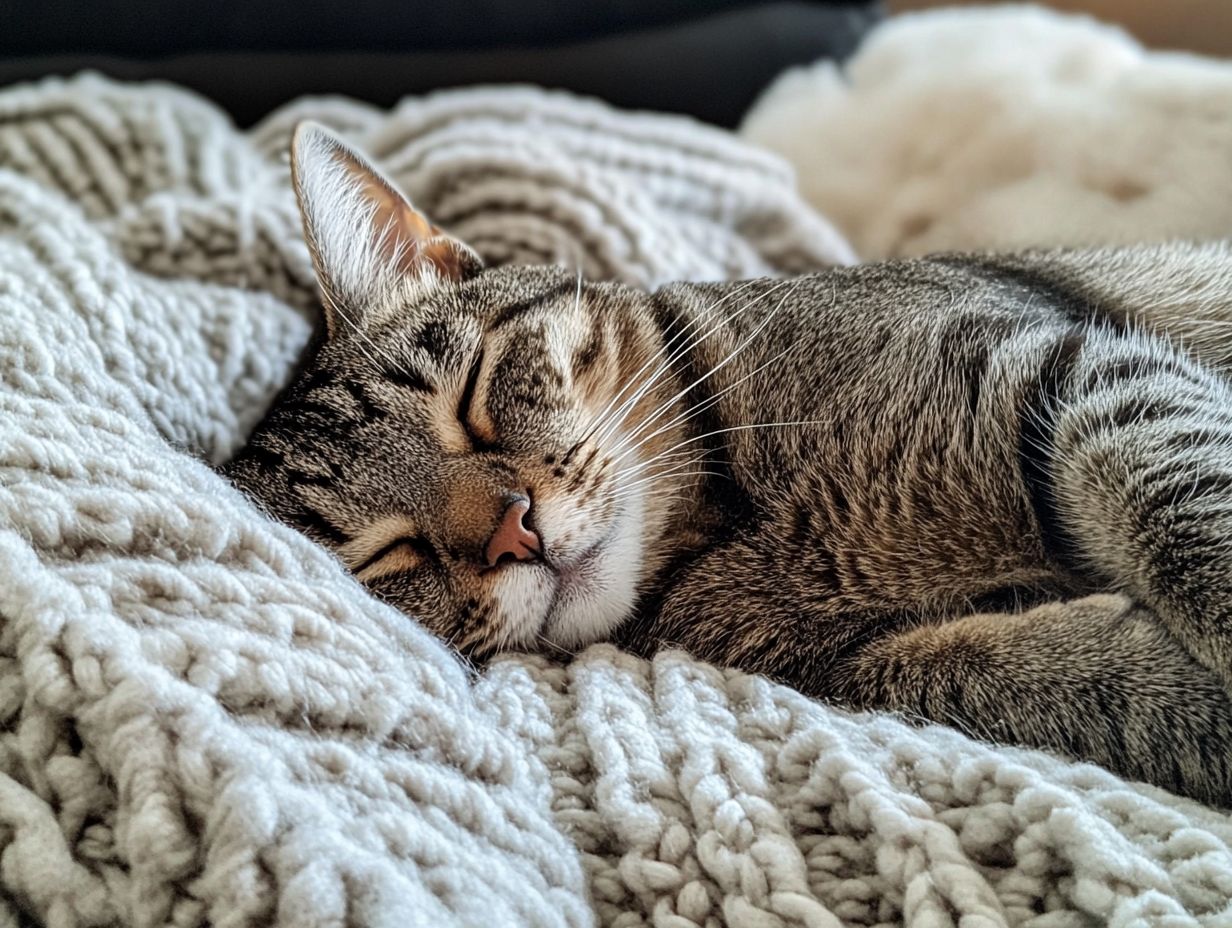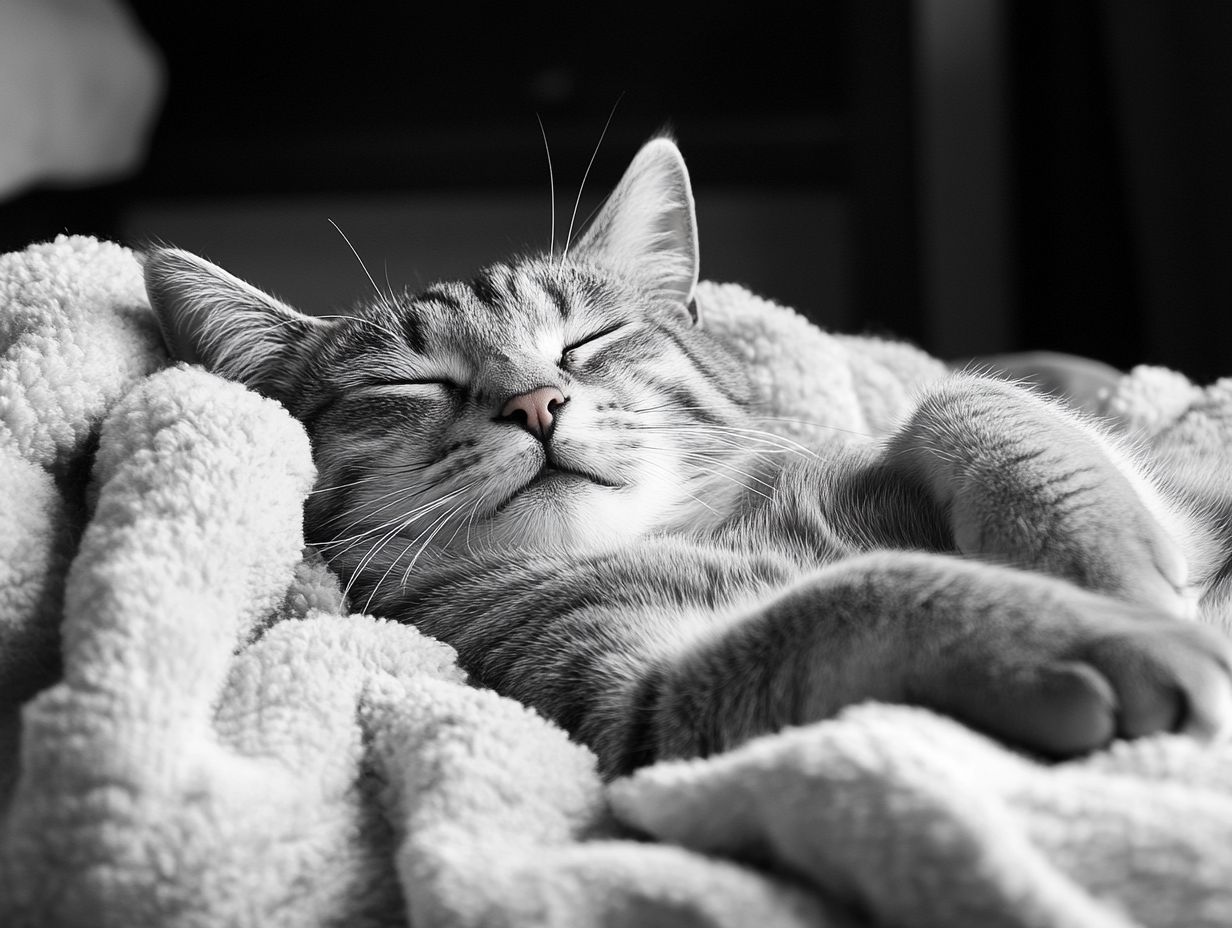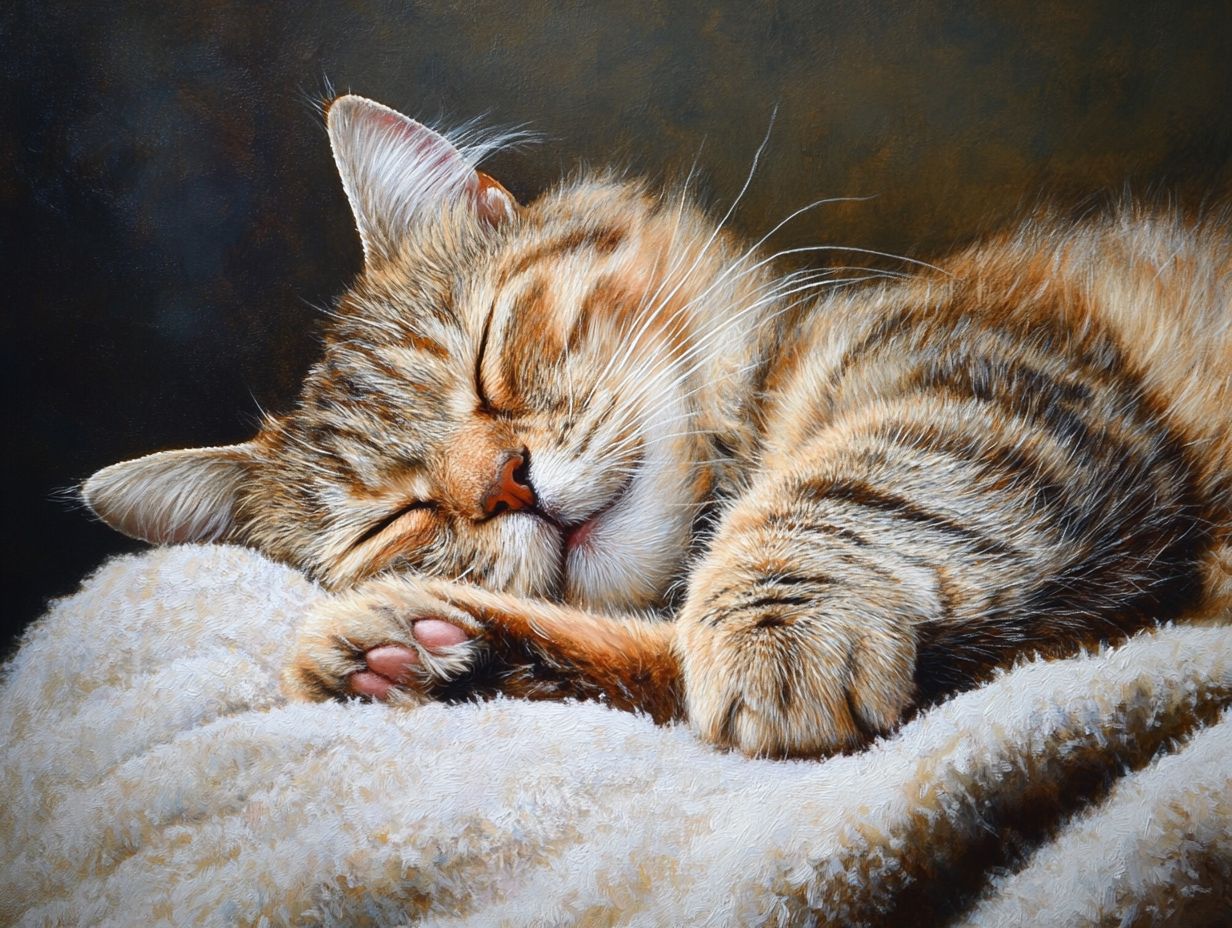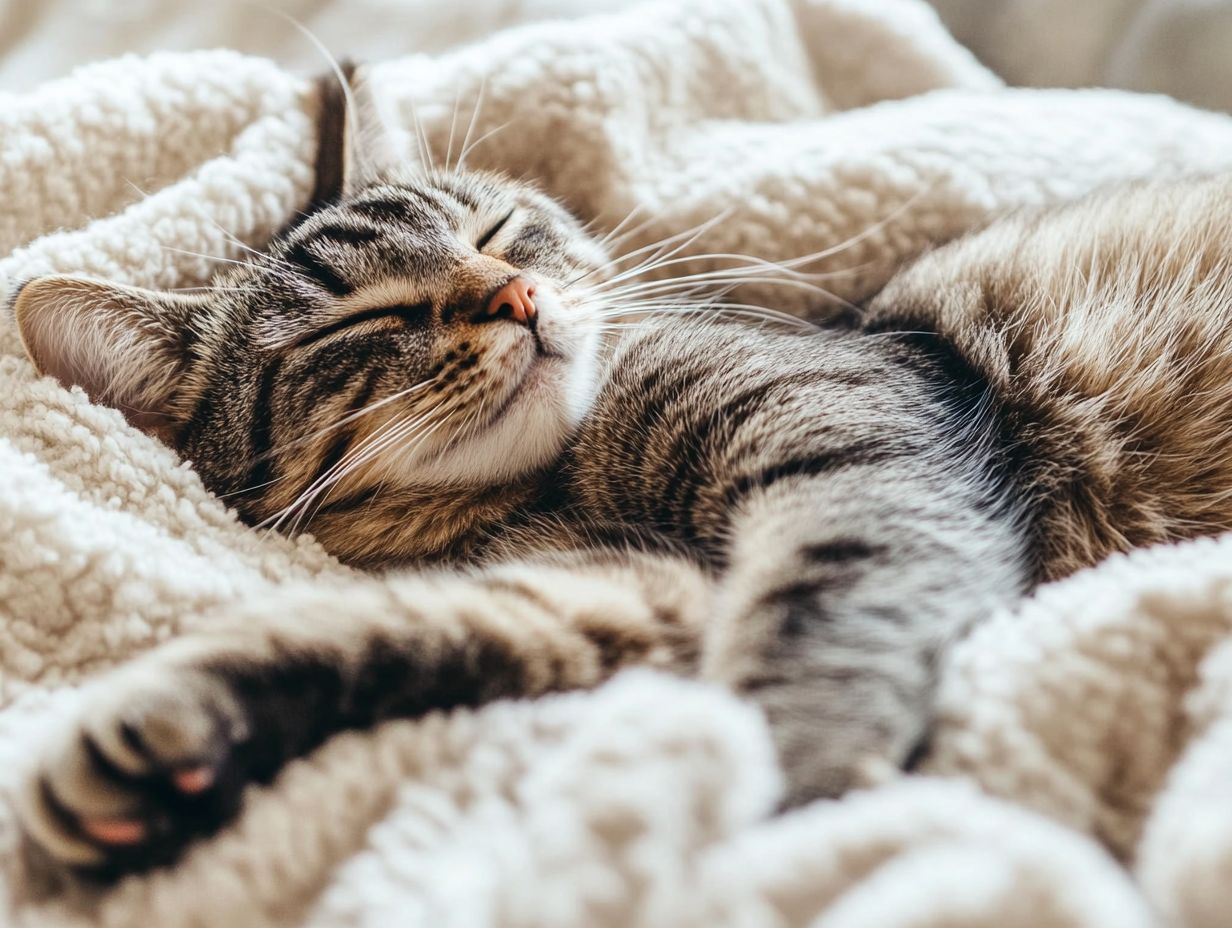Cats have a magical way of communicating, and their purr is one of the most fascinating sounds in the animal kingdom. From the soothing purrs of kittens to the distinctive vocalizations of adult cats, these unique sounds captivate us.
But what exactly is a purr, and how is it created? Beyond sheer cuteness, purring serves a variety of purposes, from expressing contentment to signaling distress. This behavior can be observed during mealtime when cats are hungry or relaxed in their happy place.
We will explore the science behind purring, the reasons why our feline friends engage in this soothing behavior, and what it means when they purr. The emotional and physical benefits of purring, such as stress relief and healing, will also be discussed.
From the cat’s viewpoint, purring is a way of communicating comfort and seeking attention from humans. Get ready to uncover the secrets of this beloved sound!
Key Takeaways:

1.
2.
3.
What is a Purr?
A purr is a low-frequency sound made by domestic cats, typically associated with their contentment and happiness. This sound is produced by rhythmic contractions of the muscles within the cat’s larynx, creating a consistent vibration. According to a study published in the Journal of Feline Medicine and Surgery, these vibrations can promote healing and stress relief.
Cats use purring to express a variety of emotions and needs. Research indicates that cats purr in different situations, ranging from relaxation to eating. This can be during feeding time or mealtime when they are particularly happy. Additionally, purring serves as an important communication tool between cats and their owners, helping to strengthen emotional bonds and ensure that cats feel comfortable in their environment. Environmental factors, such as living conditions and human interaction, play a crucial role in a cat’s purring behavior.
How is a Purr Produced?
Research into the timing and mechanics of cat purring reveals that the production of a purr involves a complex interplay of physiological mechanisms. This primarily includes the rhythmic contraction of muscles in the larynx of domestic cats, which generates distinct vibrations. The laryngeal anatomy, composed of intricate layers of muscle and cartilage, enables this unique sound.
These contractions, along with the opening and closing of the glottis, produce sound frequencies typically ranging from 25 to 150 Hertz. Animal experts have studied these vibrations and their effects on both cats and humans, suggesting that they not only benefit the cat but also provide comfort to those nearby.
A cat’s purr transcends mere mechanics; it serves as an essential means of emotional communication, indicating contentment, relaxation, or a request for attention, thereby reflecting the close bond between cats and their human caregivers. Mama cats also use purring to communicate with their kittens, fostering a bond from an early age.
What Does a Purr Sound Like?
A purr typically produces a steady, low-frequency sound that varies in volume and is often described as soothing and rhythmic, providing a calming effect for both the cat and its owner. As the sound carries, it can shift from soft to loud, reflecting the cat’s changing emotional states. This unique sound helps to create a calming atmosphere. To understand more about this fascinating behavior, check out Why Do Cats Purr?.
During moments of happiness, the purr tends to be stable and melodious, fostering a sense of comfort and togetherness. Conversely, when a cat is stressed or unwell, the purr may become more erratic or resonate at a higher pitch, indicating potential pain. This change in purring sound can signal a shift in the cat’s mood or emotional state, suggesting that owners should monitor their cat’s behavior closely.
The physical and emotional states of the cat are closely intertwined in these unique variations, making purring an intriguing language that captures the essence of feline life.
Why Do Cats Purr?
Cats purr for various reasons, including comfort, communication, and even healing. Understanding the nuances of a cat’s purring can deepen the bond between the cat and its owner. Owners should recognize that not only does purring indicate happiness, but it can also signal distress or discomfort, making it essential to pay attention to changes in purring patterns. Additionally, providing an enriched environment can encourage positive purring behavior.
Cats purr for various reasons, ranging from expressing joy and contentment to serving as important communication signals. This behavior helps them bond with humans and other cats, showcasing their emotional complexity. For more information and insights from animal experts, check out this article on why cats purr and refer to studies published in the Journal of Feline Medicine and Surgery.
1. Contentment and Happiness

Cats are most likely to purr when they are happy and comfortable in a familiar, relaxed environment, often while being gently stroked. While purring is a sign of contentment, it also serves as a means of communication for cats, expressing feelings of safety and trust. This behavior is often seen when they are in their happy place or during feeding time.
A cat’s purr, especially when curled up in a warm spot in the sun or resting in its owner’s lap, indicates their happiness. Cats may experience comfort and security when they purr, reinforcing their bond with their human companions.
2. Communication
Purring is a crucial form of communication that cats use to express their emotional needs, such as a desire for attention, affection, or comfort from their human caretakers. Along with purring, cats often employ body language and other vocalizations such as meowing to convey their feelings. Understanding these signals can enhance the human-cat bond.
Alongside purring, a gentle headbutt or slow blink frequently signals a wish for closeness. When cats approach and purr while lying next to humans, they demonstrate trust and affection, thereby strengthening their bond. Additionally, a cat’s unique vocalizations can vary significantly in different breeds, illustrating a genetic influence on communication.
The combination of purring and physical gestures indicates that cats use this sound not only as a sign of happiness but also as a clear expression of love and security.
3. Healing and Self-soothing
Purring is believed to aid in healing and self-soothing for cats. The vibrations produced by purring promote stress relief and physical comfort. These therapeutic vibrations resonate at frequencies thought to help repair bones and tissues, as shown in various studies. British researchers have studied these effects extensively, contributing to our understanding of feline behavior.
This natural mechanism allows cats to experience comfort and security while also offering calming sounds to the humans nearby. When in the presence of a purring cat, individuals may experience reduced stress, allowing for greater relaxation and clarity of thought. Experts like Stephen Quandt highlight these benefits, and for more insights, you can read about why cats purr.
The sound of purring serves as a reminder of the healing power of companionship and its ability to soothe both the heart and the mind.
4. Bonding with Humans
Purring can significantly strengthen the bond between cats and humans, as it is often associated with positive emotions and comfort. This fosters deeper connections during shared, positive interactions. Positive interactions, such as petting or gentle play, are reinforced by the sight of a cat purring while curled up on a lap.
Time spent together is typically enriched by a cat’s purring, which creates a calming atmosphere that encourages moments of tranquility and joy between the cat and its human. The trust and comfort conveyed through purring can enhance relationships further. Cats may show their well-being through purring, and pet owners can use this as a cue for positive reinforcement strategies, rewarding their purring cat with treats or affection.
These shared moments of calm and happiness nurture the emotional bond between a pet and its owner, illustrating how purring is linked to positive feelings.
Do All Cats Purr?
Not all cats purr, but most domestic cats do, and they utilize a wide variety of vocalizations and sounds that reflect their unique personalities. Cats, known for their independent nature, often use these sounds to communicate their needs and emotions.
Purring in cats can vary significantly between breeds and age groups. For instance, kittens start purring just a few days after birth, using this sound to communicate with their mothers and express happiness. This early feline training helps strengthen the kitten-mother bond. In contrast, older cats often purr more frequently during times of stress or discomfort, using the sound as a means of self-soothing.
It’s important to note that an increase in purring might indicate stress or discomfort in some situations, making connections to underlying health issues. Understanding these signals is crucial for responsible cat ownership. The purrs of various breeds, such as the Siamese and Maine Coon, illustrate how different breeds produce distinct purring sounds. These purring sounds serve as a signal to humans about the cat’s emotional and physical state.
Environmental Considerations
To foster healthy feline behavior, it’s important to consider environmental factors such as the cat’s living space, emotional state, and nurturing practices. Providing a stimulating environment with interactive toys or climbing spaces can encourage positive purring behavior. Additionally, regular vet check-ups and assessments can help ensure a cat’s emotional health.
Myth Busting
Many myths surround purring; it is often mistakenly believed to be solely a sign of happiness. In reality, purring can also indicate stress or discomfort. Understanding these nuances can help cat owners respond appropriately to their pets’ needs.
Conclusion
Overall, observing a cat’s purring behavior provides valuable insights into their emotional state and health. With ongoing learning and understanding, cat owners can enhance their relationship with their feline friends through compassion, care, and informed action.
Is Purring Always a Good Thing?

Purring is commonly associated with happiness in cats; however, it can also indicate distress, pain, or illness. Therefore, pet owners should be attentive to the context of this behavior. Veterinary experts emphasize the importance of understanding these signals for a cat’s well-being (American Veterinary Medical Association).
1. Purring in Pain or Distress
Cats may purr when they are in pain or feeling distressed, using the sound as a coping mechanism to signal their discomfort while also seeking comfort from their surroundings. In such instances, a cat’s purring can be misleading, concealing their true condition. This negative emotional response is an instinctual behavior that may require attention from a veterinarian.
Owners should look for behavioral changes, such as reluctance to move, increased hiding, or excessive grooming of a particular area. For example, if a cat is purring but also avoiding interaction, it may indicate discomfort. Recognizing these emotional cues is crucial, as they could indicate underlying medical issues.
If a purring cat exhibits aggression or seeks to retreat, it may be signaling that something is wrong and asking for their owner’s assistance and attention. Additionally, recent studies stress the importance of monitoring these behaviors to ensure timely intervention.
2. Purring in Illness or Injury
Cats may purr not only when they are content but also when they are sick or injured, using this behavior as a form of self-soothing. This can help mask symptoms and delay the need for veterinary care. Changes in appetite, behavior, energy levels, or litter box habits may signal that something is wrong, even if the cat is purring.
Pet owners should be vigilant for other indications of discomfort or health issues, such as unusual vocalizations or changes in interaction levels. Resources like the Journal of the Acoustical Society of America offer further insights into these unique behaviors.
3. Purring in Stress or Anxiety
Cats may also purr when experiencing stress or anxiety. This behavior serves as a self-soothing mechanism, helping them to find comfort even in challenging situations. Understanding the emotional context of a cat’s purring can provide insights into their well-being and overall health.
For instance, purring during a vet visit may not indicate happiness but rather a response to fear. Creating a stimulating environment with interactive toys and safe outdoor access can mitigate these stresses.
How Can You Tell If Your Cat is Purring?
You can determine if your cat is purring by closely observing their behavior, as this distinct sound is often accompanied by specific physical actions and relaxed postures. Signs of happiness include partially closed eyes, a slow blink, a gently waving tail, or a comfortably curled-up position.
These behaviors reflect their natural instincts and connection with their environment. Understanding different developmental stages (kitten, adult, senior) is key, as purring behavior may vary across these stages.
Additional Insights
Individual variation in purring behavior can depend on breed or genetics; some breeds may purr more frequently or in different contexts. Positive reinforcement is essential when encouraging desirable behaviors in cats, as punishment can lead to negative outcomes.
To monitor your cat’s health and emotional state, consider keeping a behavior diary and scheduling regular veterinary check-ups. Addressing common myths about purring, such as the misconception that all purring signifies happiness, is vital for understanding your cat’s needs.
Finally, strengthening the bond with your cat through mutual trust and understanding can alleviate stress-related behaviors and promote a healthier emotional state for your pet.
Cats may rub against their owners or purr when being stroked, which reflects their perception of comfort and is a form of communication. This behavior is particularly prominent during feeding time when they may purr to signal they are hungry. According to a study published in the Journal of the Acoustical Society of America, understanding feline vocalizations can deepen your relationship with your pet. To learn more about this behavior, check out Why Do Cats Purr?
By understanding the various ways animals express their emotions, one can enhance their relationship and interactions with their pets. This understanding is crucial for feline training and for identifying medical needs early on, especially considering the influence of the cat’s environment on their behavior. Creating a stimulating environment can encourage healthy vocalization and communication.
Frequently Asked Questions

For more detailed information, check out resources like Forbes Advisor or the Journal of the Acoustical Society of America on feline behavior.
Why Do Cats Purr?
Cats purr as a form of communication and expression of emotions, often when they are content or happy. However, they may also purr when anxious or in pain. A study published in the Journal of the Acoustical Society of America indicates that this vocalization serves various purposes, from relief to healing.
Do All Cats Purr?
Not all cats purr. While most domestic cats purr, some wild cats like lions and cheetahs do not have the ability to purr. Studies by British researchers have shown that the frequency of purring varies among different species, and certain breeds may exhibit unique vocalization habits.
Is Purring a Sign of Good Health?
Yes, purring is often a sign of good health in cats, indicating relaxation and a lack of stress or pain. Purring has therapeutic effects, promoting calmness and relaxation. Regular veterinary check-ups can help rule out medical issues that may affect purring behavior.
Can Cats Purr While Sleeping?
Yes, cats can purr while sleeping. They may do so more frequently as a comforting self-soothing mechanism. This soothing sound often creates a happy place for the cat, reflecting their comfort and calmness even in sleep.
Do Cats Only Purr When They Are Happy?
No, cats purr for various reasons beyond happiness. They may also purr when anxious, in pain, or seeking attention. This behavior is particularly noticeable in kittens, who purr to communicate needs to their mothers during kitten-mother bonding.
Why Do Cats Purr When They Are Near Humans?
Cats may purr when near humans as a way of seeking comfort and showing affection. It can also communicate their needs to their human companions. According to animal expert Stephen Quandt, this behavior illustrates the strong connection and bond between cats and humans. Rewarding a cat with treats or affection when they express themselves positively can further strengthen this bond.
Interpreting Cat Body Language
Understanding a cat’s body language is crucial when they purr. Observing their tail position or ear orientation can give insights into their emotional state, helping owners respond appropriately.
Troubleshooting Unusual Purring
Excessive or unusual purring may indicate underlying stress or health issues. It’s important for cat owners to monitor these behaviors and consult a veterinarian if necessary.
Multi-Cat Households
In multi-cat households, purring dynamics may change due to competition for attention or resources. Understanding these dynamics can help owners manage interactions effectively.
Ethical Considerations
Pet owners have an ethical responsibility to understand and respond appropriately to their cats’ vocalizations. This includes early intervention strategies to monitor purring behavior as potential signals for health checks.
Ongoing Learning
Further reading materials and resources can deepen your understanding of feline behavior. Regular engagement with reliable sources will enhance your knowledge and improve the human-cat bond.